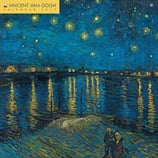Our art calendars are always stunning, showcasing iconic and less well-known artwork from treasured artists, with informative text alongside each piece – so you can learn a little every month too! Here’s a rundown of 10 of our best 2017 wall calendars featuring work from 19th-century artists.
 Degas' Dancers
Degas' Dancers
Despite associating with the Impressionists, Edgar Degas (1834–1917) considered himself a realist. Indeed, this multi-talented artist was very much an individual with his own style, and is deservedly popular today – his luminous and graceful ballet dancers, often rendered in his distinctive pastel, being his most iconic works. From the light-filled Ballet Rehearsal (1875–77) to the electric Blue Dancers (c. 1898), this delightful calendar will be a joy every month.
 Claude Monet
Claude Monet
Famous for founding and exemplifying Impressionism, Claude Monet (1840–1926) painted so many astounding works. With innovative brushwork and surprising colour combinations, he captured the essence of the ephemeral – the fleeting and many-varied effects of light and weather. This gorgeous calendar focuses on his impressive versatility in painting flowers, from the radiant Bouquet of Sunflowers (1881) to the dazzling Waterlilies and Agapanthus (c. 1914–17).
 Vincent van Gogh
Vincent van Gogh
Van Gogh (1853–90) is now so famous that it can become easy to forget just how ground-breaking this troubled artist was. His supremely expressive post-Impressionist style, bursting with colour and emotion, was to be a major influence on modern art. Featuring some of his most treasured works, such as Starry Night over the Rhone (1888) and Café Terrace at Night (1888), and less famous but equally evocative pieces like Peach Tree in Bloom (1888), this calendar will reacquaint you with a giant of Western art.
 Gustav Klimt
Gustav Klimt
Founding member and president of the Vienna Secession – Austria’s answer to Art Nouveau – Gustav Klimt (1862–1918) shook up the establishment with his often overtly sexual symbolist paintings and murals. But this is to simplify his otherworldly and incandescent works that vibrate with sinuous line and intricate patterns. This glorious calendar reveals some of his most distinctive work, such as the golden Judith I (1901) and dreamlike Water Nymphs (Silverfish) (c. 1899).
 Alphonse Mucha
Alphonse Mucha
The work of Alphonse Mucha (1860–1939) transcended the boundaries between commercial and fine art, much of it having been produced for advertisements, postcards and designs. His style is the most iconic example of Art Nouveau in two dimensions, with his flower-bedecked beauties surrounded by swirling line and ornate pattern. From the vivacity of The Arts: Dance (1898) to the sensuality of The Seasons: Summer (1896), this calendar is truly a treat for all the senses.
 Charles Rennie Mackintosh
Charles Rennie Mackintosh
Influential architect, designer and artist, Mackintosh (1868–1928) is loved for his distinctive interlacing works inspired by nature and human forms. A multi-disciplinary master, he merged beauty with function in designs for buildings, furniture, textiles and posters. This beautiful calendar features classic pieces, such as panels from the Ingram Street Tea Rooms, alongside lesser-known later paintings imbued with sunny atmosphere, such as A Southern Port (1923).
 William Morris
William Morris
The hero of the Arts & Crafts movement, Morris (1834–96) was social activist, poet and novelist in addition to talented designer. His wallpaper and textile designs have stood the test of time and continue to be cherished for their quality. This calendar features a wealth of inventive and cleverly interwoven patterns including plants, flowers and birds in beautifully complementary colours. From Chrysanthemum (1876) to Lily and Pomegranate (1886), it will never cease to please.
 Arthur Rackham
Arthur Rackham
Widely acknowledged as the leading exponent of the ‘Golden Age’ of British book illustration, Arthur Rackham (1867–1939) brought countless tales to life with his distinctive fantastical style. This calendar is a tantalising selection of his evocative illustrations of well-loved literature and children’s stories such as Alice’s Adventures in Wonderland (1907), The Legend of Sleepy Hollow (1928), The Wind in the Willows (1940) and A Midsummer Night’s Dream (1908).
 Edvard Munch
Edvard Munch
Norwegian painter and printmaker Edvard Munch (1863–1944) was a symbolist painter who truly painted from the heart, using colour. A major influence on German Expressionism, he painted to bear his soul – most famously in 1893’s The Scream. In this calendar discover more works of undulating colour that speak of anguish and woe, as in the lonely Young Girl on the Beach (1896) or Despair (1893); or drink in the more contemplative scenes such as Seaside (1898).
 Tate – J.M.W. Turner
Tate – J.M.W. Turner
J.M.W. Turner (1775–1851) was a revolutionary landscape and seascape painter, elevating the genre to an importance rivalling history painting and, indeed, as the ‘painter of light’, anticipating the techniques of Impressionism. This inviting calendar, produced in association with the Tate, showcases 12 artworks from the museum’s collection featuring Italian scenes, from the epic Tivoli: Tobias and the Angel (c.1835) to the hazily atmospheric Going to the Ball (San Martino) (ex. 1846).
Links
- If you like these calendars, check out our full catalogue here.
- For our mini calendars, head here. And to see our gorgeous slim calendars, click here.
- We have a number of new diaries and year planners for 2017 - whether you love the beautiful celestial art of Josephine Wall, or the wonderful Eden Project, we have something for you!



